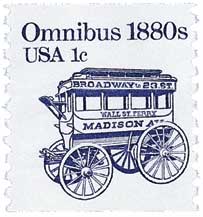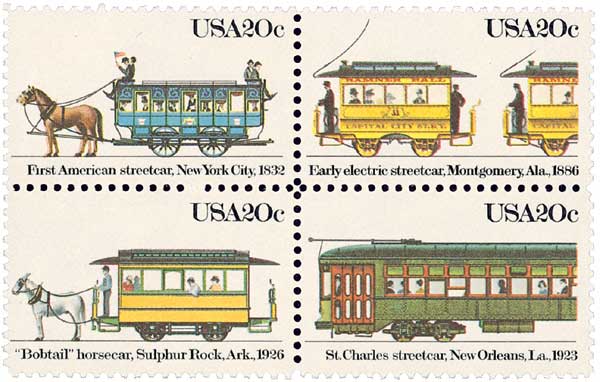
# 2059-62 - 1983 20c Street Cars
20¢ Street Cars
City: Kennebunkport, ME
Quantity: 207,725,000
Printed By: Bureau of Engraving and Printing
Printing Method: Photogravure and engraved
Perforations: 11
Color: Multicolored
First Streetcar In America
One man dominated the history of streetcars in America in the early days of their use. John Stephenson developed the first streetcar to run on rails. In general, he presided over the evolution of streetcars as public transportation.

Stephenson was an infant when his family immigrated to America in 1811. He grew up in New York City and went to college in Connecticut. A few years after Stephenson graduated, he started his own company of building “omnibuses” – horse-drawn passenger vehicles. Stephenson had worked as an apprentice under Abram Brower before striking out on his own.
It was a job order from banker John Mason that was Stephenson’s first big break. Mason wanted a passenger vehicle for a route for the New York and Harlem Railroad. Stephenson’s car was based on a modified English railway car. It ran on rails, making it a much more comfortable ride than the typically rough roads provided, and eventually earned him a sales contract. He named the car the John Mason, in honor of the man who commissioned it.
20¢ Street Cars
City: Kennebunkport, ME
Quantity: 207,725,000
Printed By: Bureau of Engraving and Printing
Printing Method: Photogravure and engraved
Perforations: 11
Color: Multicolored
First Streetcar In America
One man dominated the history of streetcars in America in the early days of their use. John Stephenson developed the first streetcar to run on rails. In general, he presided over the evolution of streetcars as public transportation.

Stephenson was an infant when his family immigrated to America in 1811. He grew up in New York City and went to college in Connecticut. A few years after Stephenson graduated, he started his own company of building “omnibuses” – horse-drawn passenger vehicles. Stephenson had worked as an apprentice under Abram Brower before striking out on his own.
It was a job order from banker John Mason that was Stephenson’s first big break. Mason wanted a passenger vehicle for a route for the New York and Harlem Railroad. Stephenson’s car was based on a modified English railway car. It ran on rails, making it a much more comfortable ride than the typically rough roads provided, and eventually earned him a sales contract. He named the car the John Mason, in honor of the man who commissioned it.

















